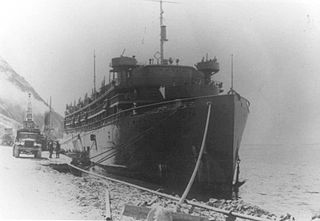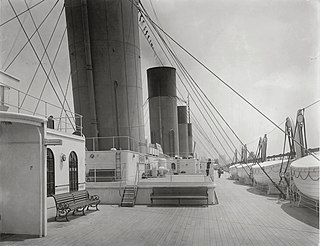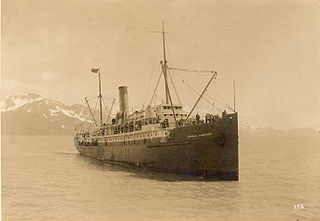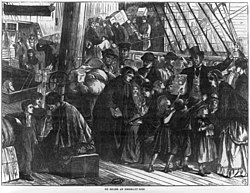
Dorchester was a coastal passenger steamship requisitioned and operated by the War Shipping Administration (WSA) in January 1942 for wartime use as a troop ship allocated to United States Army requirements. The ship was operated for WSA by its agent Atlantic, Gulf & West Indies Steamship Lines (Agwilines). The ship was in convoy SG 19 from New York to Greenland transiting the Labrador Sea when it was torpedoed by a German U-boat on February 3, 1943. The ship sank with loss of 674 of the 904 on board with one of the 230 survivors lost after rescue. The story of four Army chaplains, known as the "Four Chaplains" or the "Immortal Chaplains," who all gave away their life jackets to save others before they died, gained fame and led to many memorials.

RMS Oceanic was a transatlantic ocean liner built for the White Star Line. She sailed on her maiden voyage on 6 September 1899 and was the largest ship in the world until 1901. At the outbreak of World War I she was converted to an armed merchant cruiser. On 8 August 1914 she was commissioned into Royal Navy service.

A deck is a permanent covering over a compartment or a hull of a ship. On a boat or ship, the primary or upper deck is the horizontal structure that forms the "roof" of the hull, strengthening it and serving as the primary working surface. Vessels often have more than one level both within the hull and in the superstructure above the primary deck, similar to the floors of a multi-storey building, that are also referred to as decks, as are certain compartments and decks built over specific areas of the superstructure. Decks for some purposes have specific names.

A bulkhead is an upright wall within the hull of a ship, within the fuselage of an airplane, or a car. Other kinds of partition elements within a ship are decks and deckheads.

Marco Polo was a three-masted wooden clipper ship, launched in 1851 at Saint John, New Brunswick. She was named after Venetian traveler Marco Polo. The ship carried emigrants and passengers to Australia and was the first vessel to make the round trip from Liverpool in under six months. Later in her career, the ship was used as a cargo ship before running aground off Cavendish, Prince Edward Island, in 1883.

The Inman Line was one of the three largest 19th-century British passenger shipping companies on the North Atlantic, along with the White Star Line and Cunard Line. Founded in 1850, it was absorbed in 1893 into American Line. The firm's formal name for much of its history was the Liverpool, Philadelphia and New York Steamship Company, but it was also variously known as the Liverpool and Philadelphia Steamship Company, as Inman Steamship Company, Limited, and, in the last few years before absorption, as the Inman and International Steamship Company.

The RMS Teutonic was an ocean liner built for the White Star Line in Belfast and was the first armed merchant cruiser.

RMS Lucania was a British ocean liner owned by the Cunard Steamship Line Shipping Company, built by Fairfield Shipbuilding and Engineering Company of Govan, Scotland, and launched on Thursday, 2 February 1893.

USS Mizar (AF-12) was the United Fruit Company fruit, mail and passenger liner Quirigua that served as a United States Navy Mizar-class stores ship in World War II.

USS Talamanca (AF-15) was the United Fruit Company cargo and passenger liner Talamanca that served as a United States Navy Mizar-class stores ship in World War II.

The history of commercial passenger shipping on the Great Lakes is long but uneven. It reached its zenith between the mid-19th century and the 1950s. As early as 1844, palace steamers carried passengers and cargo around the Great Lakes. By 1900, fleets of relatively luxurious passenger steamers plied the waters of the lower lakes, especially the major industrial centres of Chicago, Milwaukee, Detroit, Cleveland, Buffalo, and Toronto.

Bristol was a large sidewheel steamboat launched in 1866 by William H. Webb of New York for the Merchants Steamship Company. One of Narragansett Bay's so-called "floating palaces", the luxuriously outfitted Bristol and her sister ship Providence, each of which could carry up to 1,200 passengers, were installed with the largest engines then built in the United States, and were considered to be amongst the finest American-built vessels of their era.

SS Monroe was an Old Dominion Steamship Company steamship launched 18 October 1902 and completed 3 April 1903 by Newport News Shipbuilding of Norfolk, Virginia for operation in the company's Old Dominion Line's "Main Line Division" for overnight service between New York and Norfolk and could make 16 knots (30 km/h). The ship had accommodations for 150 first class, 78 steerage and 53 deck passengers. That service was between New York pier 26, North River, and Norfolk connecting with the line's "Virginia Division" steamers, including Old Dominion's "Night Line Steamers" Berkley and Brandon serving Richmond with overnight service to Norfolk, other steamer lines and rail lines serving the Chesapeake Bay area. The Monroe was struck at about 2 a.m. on 30 January 1914 by the southbound steamer Nantucket and sank with loss of forty-one lives.

SS Antigua was a United Fruit Company passenger and refrigerated cargo liner completed as one of six nearly identical vessels, three built by Newport News Shipbuilding and three by Bethlehem Shipbuilding Corporation, for operation by the company's subsidiary the United Mail Steamship Company. The ship was the first of the ships built by Bethlehem Shipbuilding Corporation, Quincy, Massachusetts.

SS San Juan was a passenger steamship owned by the Los Angeles and San Francisco Navigation Company. Previously, she was owned by the Pacific Mail Steamship Company and White Flyer Line. At the age of 47 years, San Juan was involved in a collision with the steel-hulled oil tanker S.C.T. Dodd. Because of her aged iron hull, San Juan was fatally damaged in the collision and sank three minutes later, killing 65 people. The loss of San Juan was strikingly similar to the loss of Columbia.

The SS Admiral Sampson was a U.S.-flagged cargo and passenger steamship that served three owners between 1898 and 1914, when it was rammed by a Canadian passenger liner and sank in Puget Sound. Following its sinking off Point No Point, the Admiral Sampson has become a notable scuba diving destination for advanced recreational divers certified to use rebreathing equipment.

SS Tivives was a United Fruit Company passenger and refrigerated fruit cargo ship built 1911 by Workman, Clark & Company, Ltd. in Belfast. The ship was launched 1 August 1911 as Peralta but renamed before completion. As a foreign built vessel operating for a company in the United States the ship was British flagged. With outbreak of war in Europe in 1914 the ship, as did all British registered company ships, changed flag to the United States. Between 5 July 1918 and 25 April 1919 the ship was chartered and commissioned by the United States Navy for operation as USS Tivives

The Steerage Act of 1819, also called the Manifest of Immigrants Act, was an Act passed by the United States federal government on March 2, 1819, effective January 1, 1820. Its full name is An Act regulating passenger ships and vessels. It was the first law in the United States regulating the conditions of transportation used by people arriving and departing by sea. In addition to regulating conditions in ships, the act also required ship captains to deliver and report a list of passengers with their demographic information to the district collector. The Act was passed near the end of the term of the fifteenth United States Congress and signed into law by then United States President James Monroe. The Act was augmented by many additional Acts starting 1847 and finally repealed and superseded by the Carriage of Passengers Act of 1855. At the time of passage of the Act, the United States had no laws restricting immigration. In fact, the first federal legislation regulating immigration, the Page Act of 1875, was over 50 years in the future.

The Immigration Act of 1891, also known as the 1891 Immigration Act, was a modification of the Immigration Act of 1882, focusing on immigration rules and enforcement mechanisms for foreigners arriving from countries other than China. It was the second major federal legislation related to the mechanisms and authority of immigration enforcement, the first being the Immigration Act of 1882. The law was passed on March 3, 1891, at the end of the term of the 51st United States Congress, and signed into law by then United States President Benjamin Harrison.

The Carriage of Passengers Act of 1855 was an act passed by the United States federal government on March 3, 1855, replacing the previous Steerage Act of 1819 and a number of acts passed between 1847 and 1849 with new regulations on the conditions of sea transportation used by passenger ships landing in the United States. The law was passed by the 33rd United States Congress and signed into law by President Franklin Pierce.

























